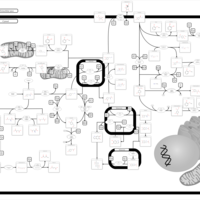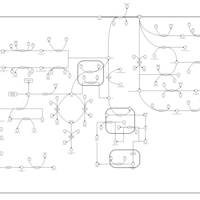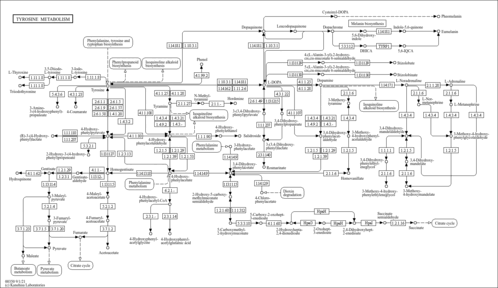| Record Information |
|---|
| Version | 1.0 |
|---|
| Created at | 2020-04-17 19:27:10 UTC |
|---|
| Updated at | 2020-12-07 19:11:53 UTC |
|---|
| CannabisDB ID | CDB005278 |
|---|
| Secondary Accession Numbers | Not Available |
|---|
| Cannabis Compound Identification |
|---|
| Common Name | Dopamine |
|---|
| Description | Dopamine, also known as 3-hydroxytyramine or deoxyepinephrine, belongs to the class of organic compounds known as catecholamines and derivatives. Catecholamines and derivatives are compounds containing 4-(2-Aminoethyl)pyrocatechol [4-(2-aminoethyl)benzene-1,2-diol] or a derivative thereof formed by substitution. Dopamine is a drug which is used for the correction of hemodynamic imbalances present in the shock syndrome due to myocardial infarction, trauma, endotoxic septicemia, open-heart surgery, renal failure, and chronic cardiac decompensation as in congestive failure. Dopamine is a very strong basic compound (based on its pKa). Dopamine exists in all living organisms, ranging from bacteria to humans. Within humans, dopamine participates in a number of enzymatic reactions. In particular, dopamine can be biosynthesized from tyramine; which is catalyzed by the enzyme tyrosinase. In addition, dopamine and ascorbic acid can be converted into norepinephrine and dehydroascorbic acid; which is mediated by the enzyme dopamine beta-hydroxylase. Catechol in which the hydrogen at position 4 is substituted by a 2-aminoethyl group. In humans, dopamine is involved in disulfiram action pathway. Outside of the human body, Dopamine is found, on average, in the highest concentration within a few different foods, such as swiss chards, oats, and red beetroots and in a lower concentration in green zucchinis, broccoli, and yellow bell peppers. Dopamine has also been detected, but not quantified in, several different foods, such as potato, banana, avocado, eggplants, and custard apples. This could make dopamine a potential biomarker for the consumption of these foods. Dopamine is a potentially toxic compound. Dopamine, with regard to humans, has been found to be associated with several diseases such as bacterial meningitis, eosinophilic esophagitis, cerebral infarction, and schizophrenia; dopamine has also been linked to the inborn metabolic disorder aromatic l-amino acid decarboxylase deficiency. Dopamine is expected to be in Cannabis as all living plants are known to produce and metabolize it. |
|---|
| Structure | |
|---|
| Synonyms | | Value | Source |
|---|
| 2-(3,4-Dihydroxyphenyl)ethylamine | ChEBI | | 3,4-Dihydroxyphenethylamine | ChEBI | | 3-Hydroxytyramine | ChEBI | | 4-(2-Aminoethyl)-1,2-benzenediol | ChEBI | | 4-(2-Aminoethyl)benzene-1,2-diol | ChEBI | | 4-(2-Aminoethyl)catechol | ChEBI | | 4-(2-Aminoethyl)pyrocatechol | ChEBI | | Deoxyepinephrine | ChEBI | | Dopamina | ChEBI | | Dopaminum | ChEBI | | Hydroxytyramin | ChEBI | | Medopa | Kegg | | 3,4-Dihydroxyphenylethylamine | HMDB | | 4-(2-Aminoethyl)-pyrocatechol | HMDB | | a-(3,4-Dihydroxyphenyl)-b-aminoethane | HMDB | | alpha-(3,4-Dihydroxyphenyl)-beta-aminoethane | HMDB | | Dopamin | HMDB | | Dopastat | HMDB | | Dophamine | HMDB | | Dynatra | HMDB | | Hydroxytyramine | HMDB | | Intropin | HMDB | | Oxytyramine | HMDB | | Revivan | HMDB | | 3,4 Dihydroxyphenethylamine | HMDB | | Hydrochloride, dopamine | HMDB | | Dopamine hydrochloride | HMDB |
|
|---|
| Chemical Formula | C8H11NO2 |
|---|
| Average Molecular Weight | 153.18 |
|---|
| Monoisotopic Molecular Weight | 153.079 |
|---|
| IUPAC Name | 4-(2-aminoethyl)benzene-1,2-diol |
|---|
| Traditional Name | dopamine |
|---|
| CAS Registry Number | 50444-17-2 |
|---|
| SMILES | NCCC1=CC(O)=C(O)C=C1 |
|---|
| InChI Identifier | InChI=1S/C8H11NO2/c9-4-3-6-1-2-7(10)8(11)5-6/h1-2,5,10-11H,3-4,9H2 |
|---|
| InChI Key | VYFYYTLLBUKUHU-UHFFFAOYSA-N |
|---|
| Chemical Taxonomy |
|---|
| Description | Belongs to the class of organic compounds known as catecholamines and derivatives. Catecholamines and derivatives are compounds containing 4-(2-Aminoethyl)pyrocatechol [4-(2-aminoethyl)benzene-1,2-diol] or a derivative thereof formed by substitution. |
|---|
| Kingdom | Organic compounds |
|---|
| Super Class | Benzenoids |
|---|
| Class | Phenols |
|---|
| Sub Class | Benzenediols |
|---|
| Direct Parent | Catecholamines and derivatives |
|---|
| Alternative Parents | |
|---|
| Substituents | - Catecholamine
- Phenethylamine
- 2-arylethylamine
- 1-hydroxy-4-unsubstituted benzenoid
- 1-hydroxy-2-unsubstituted benzenoid
- Aralkylamine
- Monocyclic benzene moiety
- Amine
- Hydrocarbon derivative
- Primary amine
- Organopnictogen compound
- Organooxygen compound
- Organonitrogen compound
- Primary aliphatic amine
- Organic oxygen compound
- Organic nitrogen compound
- Aromatic homomonocyclic compound
|
|---|
| Molecular Framework | Aromatic homomonocyclic compounds |
|---|
| External Descriptors | |
|---|
| Ontology |
|---|
|
| Physiological effect | Health effect: |
|---|
| Disposition | Route of exposure: Source: Biological location: |
|---|
| Role | Industrial application: Indirect biological role: |
|---|
| Physical Properties |
|---|
| State | Not Available |
|---|
| Experimental Properties | | Property | Value | Reference |
|---|
| Melting Point | 128 °C | Not Available | | Boiling Point | Not Available | Not Available | | Water Solubility | 535 mg/mL | Not Available | | logP | -0.98 | HANSCH,C ET AL. (1995) |
|
|---|
| Predicted Properties | [] |
|---|
| Spectra |
|---|
| EI-MS/GC-MS | | Type | Description | Splash Key | View |
|---|
| EI-MS | Mass Spectrum (Electron Ionization) | splash10-00e9-8900000000-88acdc978fe4a64e0fc5 | 2014-09-20 | View Spectrum | | GC-MS | Dopamine, non-derivatized, GC-MS Spectrum | splash10-00di-1900000000-117a1a7207245f5377e7 | Spectrum | | GC-MS | Dopamine, 4 TMS, GC-MS Spectrum | splash10-00di-1900000000-8b7dcae82868308513da | Spectrum | | GC-MS | Dopamine, non-derivatized, GC-MS Spectrum | splash10-00di-1900000000-117a1a7207245f5377e7 | Spectrum | | GC-MS | Dopamine, non-derivatized, GC-MS Spectrum | splash10-00di-1900000000-8b7dcae82868308513da | Spectrum | | Predicted GC-MS | Dopamine, non-derivatized, Predicted GC-MS Spectrum - 70eV, Positive | splash10-001i-8900000000-752bc8c11fa321b8a7ac | Spectrum | | Predicted GC-MS | Dopamine, 2 TMS, Predicted GC-MS Spectrum - 70eV, Positive | splash10-0089-9280000000-c894c19dda88ac048dd4 | Spectrum | | Predicted GC-MS | Dopamine, non-derivatized, Predicted GC-MS Spectrum - 70eV, Positive | Not Available | Spectrum | | Predicted GC-MS | Dopamine, TMS_1_1, Predicted GC-MS Spectrum - 70eV, Positive | Not Available | Spectrum | | Predicted GC-MS | Dopamine, TMS_1_2, Predicted GC-MS Spectrum - 70eV, Positive | Not Available | Spectrum | | Predicted GC-MS | Dopamine, TMS_1_3, Predicted GC-MS Spectrum - 70eV, Positive | Not Available | Spectrum | | Predicted GC-MS | Dopamine, TMS_2_2, Predicted GC-MS Spectrum - 70eV, Positive | Not Available | Spectrum | | Predicted GC-MS | Dopamine, TMS_2_3, Predicted GC-MS Spectrum - 70eV, Positive | Not Available | Spectrum | | Predicted GC-MS | Dopamine, TMS_2_4, Predicted GC-MS Spectrum - 70eV, Positive | Not Available | Spectrum | | Predicted GC-MS | Dopamine, TBDMS_1_1, Predicted GC-MS Spectrum - 70eV, Positive | Not Available | Spectrum | | Predicted GC-MS | Dopamine, TBDMS_1_2, Predicted GC-MS Spectrum - 70eV, Positive | Not Available | Spectrum | | Predicted GC-MS | Dopamine, TBDMS_1_3, Predicted GC-MS Spectrum - 70eV, Positive | Not Available | Spectrum | | Predicted GC-MS | Dopamine, TBDMS_2_1, Predicted GC-MS Spectrum - 70eV, Positive | Not Available | Spectrum | | Predicted GC-MS | Dopamine, TBDMS_2_2, Predicted GC-MS Spectrum - 70eV, Positive | Not Available | Spectrum | | Predicted GC-MS | Dopamine, TBDMS_2_3, Predicted GC-MS Spectrum - 70eV, Positive | Not Available | Spectrum | | Predicted GC-MS | Dopamine, TBDMS_2_4, Predicted GC-MS Spectrum - 70eV, Positive | Not Available | Spectrum |
|
|---|
| MS/MS | | Type | Description | Splash Key | View |
|---|
| MS/MS | LC-MS/MS Spectrum - Quattro_QQQ 10V, Positive (Annotated) | splash10-0uxu-4900000000-ff51177ebcb89b8c956c | 2012-07-24 | View Spectrum | | MS/MS | LC-MS/MS Spectrum - Quattro_QQQ 25V, Positive (Annotated) | splash10-0006-9200000000-a554eb700a06cecb8292 | 2012-07-24 | View Spectrum | | MS/MS | LC-MS/MS Spectrum - Quattro_QQQ 40V, Positive (Annotated) | splash10-014l-9000000000-db9813e1025f237a549b | 2012-07-24 | View Spectrum | | MS/MS | LC-MS/MS Spectrum - LC-ESI-QQ (API3000, Applied Biosystems) 10V, Negative | splash10-0udi-0900000000-27e0d71db6d14d79759c | 2012-08-31 | View Spectrum | | MS/MS | LC-MS/MS Spectrum - LC-ESI-QQ (API3000, Applied Biosystems) 20V, Negative | splash10-0uk9-0900000000-f1cf97c0d0dd509e229e | 2012-08-31 | View Spectrum | | MS/MS | LC-MS/MS Spectrum - LC-ESI-QQ (API3000, Applied Biosystems) 30V, Negative | splash10-00di-0900000000-aa09a2411e287abe74ed | 2012-08-31 | View Spectrum | | MS/MS | LC-MS/MS Spectrum - LC-ESI-QQ (API3000, Applied Biosystems) 40V, Negative | splash10-00di-1900000000-97c42b109cab2005373d | 2012-08-31 | View Spectrum | | MS/MS | LC-MS/MS Spectrum - LC-ESI-QQ (API3000, Applied Biosystems) 50V, Negative | splash10-006x-9700000000-974bd18febffcceea2d6 | 2012-08-31 | View Spectrum | | MS/MS | LC-MS/MS Spectrum - LC-ESI-QQ (API3000, Applied Biosystems) 10V, Positive | splash10-0f79-0900000000-099173d4201beca9e548 | 2012-08-31 | View Spectrum | | MS/MS | LC-MS/MS Spectrum - LC-ESI-QQ (API3000, Applied Biosystems) 20V, Positive | splash10-000i-1900000000-9dc09f2661247c9d84b0 | 2012-08-31 | View Spectrum | | MS/MS | LC-MS/MS Spectrum - LC-ESI-QQ (API3000, Applied Biosystems) 30V, Positive | splash10-0006-9300000000-8b85fa9aac1ffb4c2873 | 2012-08-31 | View Spectrum | | MS/MS | LC-MS/MS Spectrum - LC-ESI-QQ (API3000, Applied Biosystems) 40V, Positive | splash10-0006-9000000000-9ea16d2057010279d433 | 2012-08-31 | View Spectrum | | MS/MS | LC-MS/MS Spectrum - LC-ESI-QQ (API3000, Applied Biosystems) 50V, Positive | splash10-014l-9000000000-32ca2db8fe2b4729ab94 | 2012-08-31 | View Spectrum | | MS/MS | LC-MS/MS Spectrum - LC-ESI-QQ (API3000, Applied Biosystems) 10V, Positive | splash10-0f79-0900000000-ff587935c79b4592ffcf | 2012-08-31 | View Spectrum | | MS/MS | LC-MS/MS Spectrum - LC-ESI-QQ (API3000, Applied Biosystems) 20V, Positive | splash10-000i-1900000000-8a35d8a2241bc18d6c50 | 2012-08-31 | View Spectrum | | MS/MS | LC-MS/MS Spectrum - LC-ESI-QQ (API3000, Applied Biosystems) 30V, Positive | splash10-0006-9300000000-356a4b8f268863c7893e | 2012-08-31 | View Spectrum | | MS/MS | LC-MS/MS Spectrum - LC-ESI-QQ (API3000, Applied Biosystems) 40V, Positive | splash10-0006-9000000000-a88c1004f357858fbc6c | 2012-08-31 | View Spectrum | | MS/MS | LC-MS/MS Spectrum - LC-ESI-QQ (API3000, Applied Biosystems) 50V, Positive | splash10-014l-9000000000-271874005dcb90288512 | 2012-08-31 | View Spectrum | | MS/MS | LC-MS/MS Spectrum - LC-ESI-QFT , negative | splash10-0udi-0900000000-cfa7e1cb9f02ffb4447d | 2017-09-14 | View Spectrum | | Predicted MS/MS | Predicted LC-MS/MS Spectrum - 10V, Positive | splash10-0udr-0900000000-4e409c6edda911de39fe | 2017-06-28 | View Spectrum | | Predicted MS/MS | Predicted LC-MS/MS Spectrum - 20V, Positive | splash10-000i-1900000000-90aa0e0866454c2eacc7 | 2017-06-28 | View Spectrum | | Predicted MS/MS | Predicted LC-MS/MS Spectrum - 40V, Positive | splash10-1000-9400000000-210fd696305d8cf76164 | 2017-06-28 | View Spectrum | | Predicted MS/MS | Predicted LC-MS/MS Spectrum - 10V, Negative | splash10-0udi-0900000000-ff95007680e484d3c57e | 2017-06-28 | View Spectrum | | Predicted MS/MS | Predicted LC-MS/MS Spectrum - 20V, Negative | splash10-0udi-1900000000-6dcfecebbd98220ef746 | 2017-06-28 | View Spectrum | | Predicted MS/MS | Predicted LC-MS/MS Spectrum - 40V, Negative | splash10-0kil-6900000000-f476cfd569c441bc84aa | 2017-06-28 | View Spectrum |
|
|---|
| NMR | | Type | Description | | View |
|---|
| 1D NMR | 1H NMR Spectrum (1D, 600 MHz, H2O, experimental) | | Spectrum | | 1D NMR | 1H NMR Spectrum (1D, 100 MHz, D2O, predicted) | | Spectrum | | 1D NMR | 13C NMR Spectrum (1D, 100 MHz, D2O, predicted) | | Spectrum | | 1D NMR | 1H NMR Spectrum (1D, 1000 MHz, D2O, predicted) | | Spectrum | | 1D NMR | 13C NMR Spectrum (1D, 1000 MHz, D2O, predicted) | | Spectrum | | 1D NMR | 1H NMR Spectrum (1D, 200 MHz, D2O, predicted) | | Spectrum | | 1D NMR | 13C NMR Spectrum (1D, 200 MHz, D2O, predicted) | | Spectrum | | 1D NMR | 1H NMR Spectrum (1D, 300 MHz, D2O, predicted) | | Spectrum | | 1D NMR | 13C NMR Spectrum (1D, 300 MHz, D2O, predicted) | | Spectrum | | 1D NMR | 1H NMR Spectrum (1D, 400 MHz, D2O, predicted) | | Spectrum | | 1D NMR | 13C NMR Spectrum (1D, 400 MHz, D2O, predicted) | | Spectrum | | 1D NMR | 1H NMR Spectrum (1D, 500 MHz, D2O, predicted) | | Spectrum | | 1D NMR | 13C NMR Spectrum (1D, 500 MHz, D2O, predicted) | | Spectrum | | 1D NMR | 1H NMR Spectrum (1D, 600 MHz, D2O, predicted) | | Spectrum | | 1D NMR | 13C NMR Spectrum (1D, 600 MHz, D2O, predicted) | | Spectrum | | 1D NMR | 1H NMR Spectrum (1D, 700 MHz, D2O, predicted) | | Spectrum | | 1D NMR | 13C NMR Spectrum (1D, 700 MHz, D2O, predicted) | | Spectrum | | 1D NMR | 1H NMR Spectrum (1D, 800 MHz, D2O, predicted) | | Spectrum | | 1D NMR | 13C NMR Spectrum (1D, 800 MHz, D2O, predicted) | | Spectrum | | 1D NMR | 1H NMR Spectrum (1D, 900 MHz, D2O, predicted) | | Spectrum | | 1D NMR | 13C NMR Spectrum (1D, 900 MHz, D2O, predicted) | | Spectrum | | 2D NMR | [1H, 13C]-HSQC NMR Spectrum (2D, 600 MHz, H2O, experimental) | | Spectrum |
|
|---|
| Pathways |
|---|
| Pathways | | Name | SMPDB/Pathwhiz | KEGG | | Tyrosine Metabolism |    |  | | Catecholamine Biosynthesis |    |  | | Aromatic L-Aminoacid Decarboxylase Deficiency |    | Not Available | | Tyrosine hydroxylase deficiency |    | Not Available | | Alkaptonuria |    | Not Available |
|
|---|
| Protein Targets |
|---|
| Enzymes | |
|---|
| Transporters | |
|---|
| Metal Bindings | |
|---|
| Receptors | |
|---|
| Transcriptional Factors | Not Available |
|---|
| Concentrations Data |
|---|
| Not Available |
|---|
| External Links |
|---|
| HMDB ID | HMDB0000073 |
|---|
| DrugBank ID | DB00988 |
|---|
| Phenol Explorer Compound ID | Not Available |
|---|
| FoodDB ID | FDB012163 |
|---|
| KNApSAcK ID | C00001408 |
|---|
| Chemspider ID | 661 |
|---|
| KEGG Compound ID | C03758 |
|---|
| BioCyc ID | DOPAMINE |
|---|
| BiGG ID | 42467 |
|---|
| Wikipedia Link | Dopamine |
|---|
| METLIN ID | 64 |
|---|
| PubChem Compound | 681 |
|---|
| PDB ID | Not Available |
|---|
| ChEBI ID | 18243 |
|---|
| References |
|---|
| General References | Not Available |
|---|
